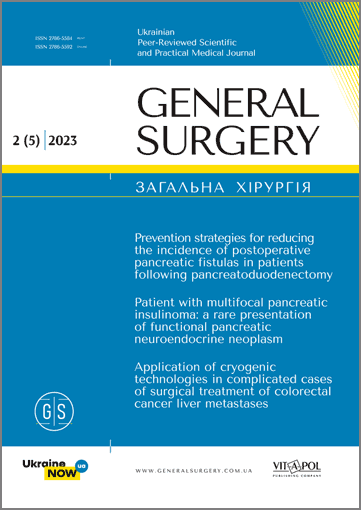Application of cryogenic technologies in complicated cases of surgical treatment of colorectal cancer liver metastases. Case report
DOI:
https://doi.org/10.30978/GS-2023-2-69Keywords:
colorectal cancer, liver metastases, split in situ, liver resection, ALPPS, cryoablation, vascular invasionAbstract
Surgical resection is a standard treatment strategy for both primary and secondary malignant liver neoplasms. Liver transplantation is considered the most effective treatment method for colorectal cancer liver metastasis. Palliative debulking liver resection is one of the optimal alternative procedures for patients ineligible for a liver transplant, as it improves overall survival. Resectability rates depend on the functional efficiency of the remaining portion of the liver, which can be improved by increasing the future liver remnant. The application of cryogenic technologies for the ablation of a residual tumour invading the intraparenchymal segments of the major hepatic vessel may have advantages in cases where it is impossible to expand the scope of the surgical intervention due to the insufficiency of the future liver remnant and/or the presence of severe concomitant pathology.
Objective — to present a case report of cryogenic technology application in complicated cases of surgical treatment of patients with colorectal cancer liver metastases.
Case report. The case report presents an experience of cryoablation of the metastasis tissue with invasion into the intraparenchymal portal branch of Sg III, which was revealed during the I stage of the split in situ/ligation of the portal vein (ALPPS) liver resection. Cryoablation was performed by the application method with a single cryocycle and spontaneous thawing. Device — Cryo‑Pulse (Ukraine). Cryoagent — liquid nitrogen (T ‑180...‑196°С). Exposure time was 3 min. The specific complications associated with cryoablation were not observed.
Conclusions. The application of cryogenic technologies for combined debulking surgical treatment of malignant focal liver lesions may be a safe treatment option in cases of residual tumour invasion into portal vein branches. The study is still ongoing.
References
Adam R, Kitano Y, Abdelrafee A, Allard MA, Baba H. Debulking surgery for colorectal liver metastases: Foolish or chance?. Surg Oncol. 2020;33:266-9. http://doi.org/10.1016/j.suronc.2020.02.008.
Andreou A, Knitter S, Schmelzle M, et al. Recurrence at surgical margin following hepatectomy for colorectal liver metastases is not associated with R1 resection and does not impact survival. Surgery. 2021;169(5):1061-8. http://doi.org/10.1016/j.surg.2020.11.024.
Aquina CT, Eskander MF, Pawlik TM. Liver-directed treatment options following liver tumor recurrence: a review of the literature. Front Oncol. 2022;12:832405. Published 2022 Jan 31. http://doi.org/10.3389/fonc.2022.832405.
Chan KS, Low JK, Shelat VG. Associated liver partition and portal vein ligation for staged hepatectomy: a review. Transl Gastroenterol Hepatol. 2020;5:37. Published 2020 Jul 5. http://doi.org/10.21037/tgh.2019.12.01.
Imai K, Adam R, Baba H. How to increase the resectability of initially unresectable colorectal liver metastases: A surgical perspective. Ann Gastroenterol Surg. 2019;3(5):476-86. Published 2019 Jul 11. http://doi.org/10.1002/ags3.12276.
Liu Y, Yang Y, Gu S, Tang K. A systematic review and meta-analysis of associating liver partition and portal vein ligation for staged hepatectomy (ALPPS) versus traditional staged hepatectomy. Medicine (Baltimore). 2019;98(15):e15229. http://doi.org/10.1097/MD.0000000000015229.
Radulova-Mauersberger O, Weitz J, Riediger C. Vascular surgery in liver resection. Langenbecks Arch Surg. 2021;406(7):2217-48. http://doi.org/10.1007/s00423-021-02310-w.
Schadde E, Raptis DA, Schnitzbauer AA, et al. Prediction of mortality after ALPPS Stage-1: An analysis of 320 patients from the International ALPPS Registry. Ann Surg. 2015;262(5):780-6. http://doi.org/10.1097/SLA.0000000000001450.
Sandström P, Røsok BI, Sparrelid E, et al. ALPPS improves resectability compared with conventional two-stage hepatectomy in patients with advanced colorectal liver metastasis: results from a Scandinavian Multicenter Randomized Controlled Trial (LIGRO Trial). Ann Surg. 2018;267(5):833-40. http://doi.org/10.1097/SLA.0000000000002511.
Wanis KN, Linecker M, Madenci AL, et al. Variation in complications and mortality following ALPPS at early-adopting centers. HPB (Oxford). 2021;23(1):46-55. http://doi.org/10.1016/j.hpb.2020.04.009.
Dronov AI, Skomarovsky AA, Bakunets YP, et al. Split in situ liver resection for synchronous colorectal metastases. Surgery. Eastern Europe. 2015;(4):127-36. http: // recipe.by/wp-content/uploads/woocommerce_uploads/2016/10/4_2015_KHirurgiya_all.pdf .
Sainani NI, Silverman SG, Tuna IS, et al. Incidence and clinical sequelae of portal and hepatic venous thrombosis following percutaneous cryoablation of liver tumors. Abdom Radiol (NY). 2016;41(5):970-7. http://doi.org/10.1007/s00261-015-0626-2.
Ladd AP, Rescorla FJ, Baust JG, Callahan M, Davis M, Grosfeld JL. Cryosurgical effects on growing vessels. Am Surg. 1999;65(7):677-82. PMID: 10399979.
Esposito P, Matteo M, Concepcion C, Montanarella M, Matteo J. Portal vein tumor thrombus: no longer a death sentence. Cureus. 2021;13(1):e12845. Published 2021 Jan 21. http://doi.org/10.7759/cureus.12845.
Soule E, Matteo J. Finally, a minimally invasive option for intrahepatic inferior vena cava invasion by hepatocellular carcinoma. Gastrointest Tumors. 2018;5(1-2):54-61. http://doi.org/10.1159/000491694.
Dronov AI, et al. 15-year experience in the application of cryosurgical technologies in the treatment of patients with neoplasia of the liver and pancreas. Surgery. Eastern Europe. 2019;8(1):57-66.
Kozachuk Ye.S. Evaluation of the effectiveness of the cryosurgical method in the complex treatment of patients with focal liver pathology (clinical and experimental study) [dissertation]. Kyiv, Ukraine; Bogomolets National Medical University; 2020. 208 p.
Downloads
Published
How to Cite
Issue
Section
License
Copyright (c) 2023 Authors

This work is licensed under a Creative Commons Attribution-NoDerivatives 4.0 International License.






